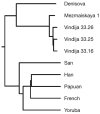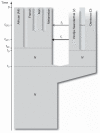Genetic history of an archaic hominin group from Denisova Cave in Siberia
- PMID: 21179161
- PMCID: PMC4306417
- DOI: 10.1038/nature09710
Genetic history of an archaic hominin group from Denisova Cave in Siberia
Abstract
Using DNA extracted from a finger bone found in Denisova Cave in southern Siberia, we have sequenced the genome of an archaic hominin to about 1.9-fold coverage. This individual is from a group that shares a common origin with Neanderthals. This population was not involved in the putative gene flow from Neanderthals into Eurasians; however, the data suggest that it contributed 4-6% of its genetic material to the genomes of present-day Melanesians. We designate this hominin population 'Denisovans' and suggest that it may have been widespread in Asia during the Late Pleistocene epoch. A tooth found in Denisova Cave carries a mitochondrial genome highly similar to that of the finger bone. This tooth shares no derived morphological features with Neanderthals or modern humans, further indicating that Denisovans have an evolutionary history distinct from Neanderthals and modern humans.
Figures




Comment in
-
Human origins: Shadows of early migrations.Nature. 2010 Dec 23;468(7327):1044-5. doi: 10.1038/4681044a. Nature. 2010. PMID: 21179156 No abstract available.
References
-
- Pope GG. Craniofacial evidence for the origin of modern humans in China. Am. J. Phys. Anthropol. 1992;35(Suppl. 15):243–298.
-
- Rightmire GP. Brain size and encephalization in early to Mid-Pleistocene Homo. Am. J. Phys. Anthropol. 2004;124:109–123. - PubMed
-
- Wu X, Poirier FE. Human Evolution in Asia. Oxford Univ. Press; 1995.
-
- Brown P, et al. A new small-bodied hominin from the Late Pleistocene of Flores, Indonesia. Nature. 2004;431:1055–1061. - PubMed
Publication types
MeSH terms
Substances
Associated data
- Actions
Grants and funding
LinkOut - more resources
Full Text Sources
Other Literature Sources

